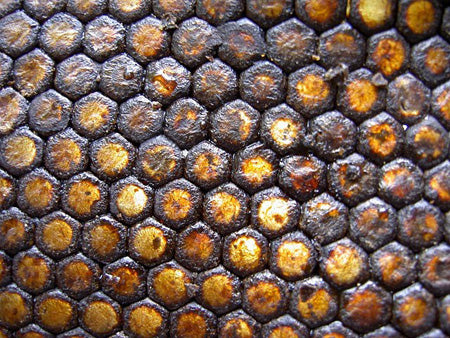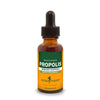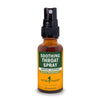You are about to leave the Herb Pharm website. The website will open in a new browser window.
Please select "OK" to continue to the website, or close this box to return to Herb-Pharm.com.

Resina propoli
Plant Family
none
Other Names
Bee Propolis, Propolis Balsam, Propolis Resin, Propolis Wax.5
Parts Used
resin
Uses
Supports the immune system.*
Prominent Phytochemicals
Prominent Constituents as Reported in Scientific Literature: Flavonoids, resins, volatile oils and phenolic acids and their esters.3,8,9 Depending on the tree and bee species, phenylpropanoids, benzophenone derivatives, C-prenylflavanones, diterpenes or triterpenoids may be found.8,9
Often referred to as bee glue, scrapings or secretions, it is made from a mixture of bee saliva, enzymes, beeswax, pollen, possibly honey and resins from nearby plants.3,9
Botanical Description
Propolis is green, yellow, dark red or brown, with a sweet, aromatic smell.3,4,6 Like wax, it has a dry and soft paste consistency that is easy to smear.4
Origins & History
Propolis is a resin substance that the Western or European honeybee (Apis mellifera) and some stingless bees (meliponines) commonly make.2,3 Often referred to as bee glue, scrapings or secretions, it is made from a mixture of bee saliva, enzymes, beeswax, pollen, possibly honey and resins from nearby plants.3,9 Plants secrete sticky fat-soluble exudates of gums, latexes, mucilages and resins to protect new buds and young leaves until they mature, or to seal wounds in their tissues to guard against microbes or the elements.1,3 In the springtime, bees collect the resins of varying plant materials mostly high up in trees, making it difficult for humans to observe.1,2,7,9 They seek out varied parts of the plant, such as bark, flower buds, stems or leaves.1,9 Bees excise small parts of the plants or gather it from plant wounds and masticate them to separate the resins from the trichomes and ducts.1,3 The substance is secured to the pollen baskets on their hind legs and then transported to the hive to create Propolis.1 They may sometimes collect a bit of the vegetation for the production process.1
Analytic tests have shown that Cottonwood trees (Populus spp.) and other Poplar species are the predominant source for Propolis resins in the North Temperate Zone and temperate regions, such as Australia.1,2,3,9 In Russia, European White Birch (Betula pendula syn. B. verrucosa) is the most common source of resin for Propolis production for the last 30-plus years.1,9 In subtropical climates like the Mediterranean, conifers are the main source; the Mediterranean Cypress (Cupressus sempervirens) is the common species.1,9 In Latin America, the Clusia species is an important source of flower resins, while Brazil has 13 different types of brown, green and red Propolis.9 Green Propolis is from Baccharis dracunculifolia and other Baccharis species, while Red Propolis is from Coinvine (Dalbergia ecastaphyllum), also found in Cuba and Mexico.9 According to herbalist Michael Moore, the superior Propolis is harvested by bees in the spring from Aspen, Birch, Poplar and Willow trees, but it is also known to come from Beech, Elm and Conifers.3,7
Bees use Propolis for many practices around the hive. It is most often utilized as a type of glue for structure support.3 It can also close cracks in hives, offer protection from any intruders, create a microbe-free environment and even be used as overlay for comb attachment and as an embalming tool for invaders to the hive that have died and can’t be removed.2,3,6 It is often added to the base or mouth of the hive or other areas that need to be shielded from outside air.1,4,6 The name Propolis originated from pro translated as “at the entrance to” or “in front of”, and polis meaning “city” or “community” in Greek.3 Unlike manmade hives, the interior of beehives located in trees are completely coated in the secretions for protection.2 The bee scrapings also protect the combs, honey and larvae from contagious issues.3
In Europe and the Middle East, Propolis has been applied topically and the smoke inhaled since approximately 300 B.C.1 Pliny the Elder, a Roman naturalist, and Dioscorides, a Greek physician and herbalist, both recorded the use of Propolis in their respective herbals in the first century.3,4 While used in herbalism, the bee scrapings are also used in bee therapy, called apitherapy, which also uses honey, pollen, royal jelly and bee venom.9 The bee secretions are insoluble in water but can be extracted in alcohol.6 Alcohol extractions, such as tinctures, are superior to raw Propolis, as the extraction process makes phytochemicals more readily available.9 Propolis is also consumed within the food and beverages industry.3
References
Don't forget! Check your Rewards account for coupons.
CHECKOUTYou are about to leave the Herb Pharm website. The American Association of Naturopathic Physicians website will open in a new browser window.
Please select "OK" to continue to the American Association of Naturopathic Physicians website, or close this box to return to Herb-Pharm.com.
You are about to leave the Herb Pharm website. The website will open in a new browser window.
Please select "OK" to continue to the website, or close this box to return to Herb-Pharm.com.

